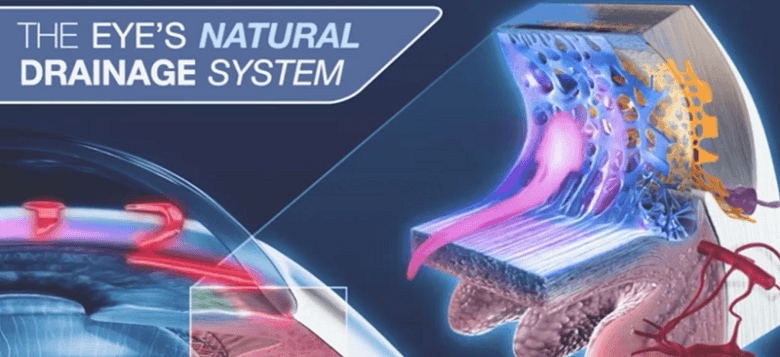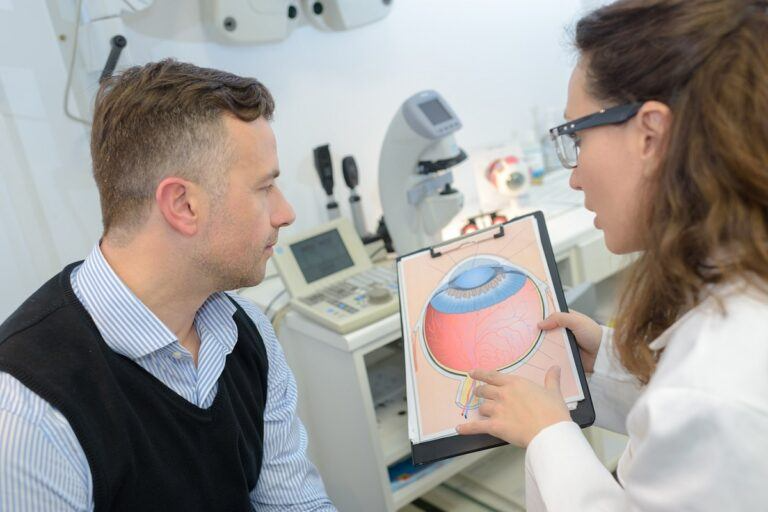How to Preserve Vision if You Have Neovascular Glaucoma
Sub Title

Neovascular glaucoma is one type of glaucoma that can develop in the eyes when the trabecular meshwork, or “drain of the eye,” is not functioning correctly. This type of glaucoma is frequently associated with certain other medical conditions including heart disease and diabetes. It is considered a “secondary” type of glaucoma since it develops as a result of another medical condition.
How Normal Eyes Function
Fluid is produced behind the iris, the colored part of the eye. It then passes through the pupil, the dark part of the eye, and fills the anterior chamber of the eye between the iris and cornea, the clear outer part of the eye.
The fluid then drains through the trabecular meshwork, which creates a 360-degree band or drain around the angle of the eye. When the trabecular meshwork is not functioning correctly, the fluid cannot drain, causing the pressure in the eye to increase—a common symptom of the various types of glaucoma.
What Causes Neovascular Glaucoma?
The primary cause of this type of glaucoma is an over-production of blood vessels in the eyes. The blood vessels develop in the area near the trabecular meshwork. As they develop, the angle of the eye is narrowed and the drainage process slowly starts to become blocked. Eventually, the fluid cannot drain correctly, leading to the development of neovascular glaucoma.
What Are the Symptoms of Neovascular Glaucoma?
The symptoms associated with neovascular glaucoma tend to develop in stages. Vision damage caused by glaucoma is irreversible. It is important to pay attention to these symptoms, as the sooner you suspect glaucoma, the sooner it can be treated and vision loss halted.
Stage 1 Neovascular Glaucoma: You notice light sensitivity to bright lights. The eyes can appear red around the iris. You may notice your pupils do not open and contract as much.
Stage 2 Neovascular Glaucoma: You start to experience frequent headaches. The eye can look red all the time and there may be pain. You notice your sensitivity to light increases. The pupils do not react as well to changes in light.
Stage 3 Neovascular Glaucoma: You can feel nauseated, vomit, and the headaches worsen. The pain in the eyes becomes severe. Your pupils remain in a fixed position. You cannot tolerate any light levels due to severe light sensitivity.
The stages will progress differently from one person to another. Some people may notice only moderate changes over several years. Other people may notice their symptoms are worsening at a much faster pace.
Neovascular Glaucoma Treatment
The specific neovascular glaucoma treatment required is customized to the needs of the patient by their glaucoma specialist. Some of the more common treatment options include:
1. Medical Therapy: Prescription eye drops are used to help shrink the blood vessels and reopen the meshwork.
2. SLT Laser Eye Surgery: This quick, painless, and very safe in-office laser eye surgery opens the drain of the eye over a six-week period, through a process that is not yet fully understood. SLT surgery is effective in about 75% of patients.
3. Minimally Invasive Glaucoma Surgery: This surgery can be prescribed with other treatments or used as a stand-alone procedure to restore proper fluid drainage.
4. Incisional Glaucoma Surgery: This surgery is only used for severe and advanced neovascular glaucoma patients or if other treatments have not been effective.

It should be noted that how to preserve vision with neovascular glaucoma does require at least one or a combination of these treatments. There are no “natural” or “homeopathic” glaucoma treatments that will stop vision loss. If the glaucoma is not treated, total vision loss and blindness will occur.
If you suspect you might have neovascular glaucoma or would like to be checked for this condition, please fee free to contact Dougherty Laser Vision at (805) 870-9482 to schedule an appointment today!

